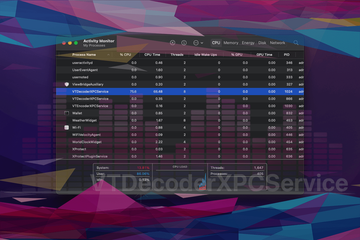- What is VTDecoderXPCService on Mac?
- When does VTDecoderXPCService get out of hand?
- VTDecoderXPCService high memory and CPU virus manual removal from Mac
- Get rid of VTDecoderXPCService related malware in web browser on Mac
- Fix VTDecoderXPCService high CPU and memory issue using Combo Cleaner removal tool
This article should be helpful to those puzzled over occasional CPU and memory usage spikes by the VTDecoderXPCService process on Mac.
What is VTDecoderXPCService on Mac?
No matter how well-polished an operating system is from the software engineering perspective, it isn’t devoid of snags that throw a spanner in the works at times. When it comes to the Mac – even a shiny brand new one – smooth performance is not guaranteed, and the reason doesn’t necessarily boil down to some junk app or an awfully long macOS update hiatus. Sometimes, native system processes may go on a rampage and cause the machine to slow down. The object called VTDecoderXPCService is quite often the culprit as its CPU and memory usage patterns may suddenly deviate towards abnormal heights. The whys and wherefores of this mischief will be analyzed further down. In the meanwhile, let’s see what this thing is supposed to do. VTDecoderXPCService is part of the VideoToolbox framework, which provides applications with a basic spectrum of services for video compression, decompression, and conversion between certain types of formats.
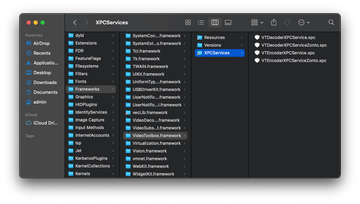
In other words, if the activity of an arbitrary program involves multimedia content in one form or another, and if it requires direct access to hardware-accelerated video decoding or encoding on a Mac, then the above-mentioned framework kicks in. Specifically, its component named XPCServices is what harbors the necessary instruments, including VTDecoderXPCService. It is responsible for interprocess communication at the level of helper tools that facilitate particular facets of the application. A common example is a scenario where your browser calls this process to play videos. Rendering audio materials is part of its responsibility as well, by the way. The degree of this involvement depends on how graphically intensive a visited website is. When viewing content on YouTube or Facebook, for instance, VTDecoderXPCService might be among the most resource-intensive processes in Activity Monitor’s graph.
The VTDecoderXPCService high CPU and memory virus may re-infect your Mac multiple times unless you delete all of its fragments, including hidden ones. Therefore, it is recommended to download Combo Cleaner and scan your system for these stubborn files. This way, you may reduce the cleanup time from hours to minutes.
Download Now Learn how Combo Cleaner works. If the utility spots malicious code, you will need to buy a license to get rid of it.When does VTDecoderXPCService get out of hand?
As previously stated, the system tool in question tends to become a resource hog when it’s used by an application that renders videos and audio materials. The good news is that the CPU and memory consumption usually stays within the moderate limits, but sometimes it skyrockets to as high as 100% or above that verge. For the record, the ostensibly highest possible percentage may be exceeded when a process gobbles up all the power of more than one logical CPU on your chip. This condition causes a slowdown problem and keeps the Mac hot even despite the fan speed being maxed out continuously. In these periods, the Activity Monitor will most likely show more than one instance of VTDecoderXPCService. If this predicament occurs, it’s worth determining the original catalyst so that you know what troubleshooting techniques to prioritize.
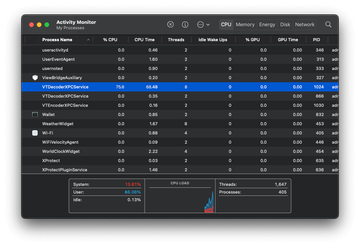
Many users who have bumped into the VTDecoderXPCService high CPU and memory issue discover that the situation goes back to normal after they quit the Messages app. The reason is trivial: just like the average modern messaging service, it processes a lot of multimedia content. This includes web previews, inline videos, gifs, and audio data. It comes as no surprise that the system instruments geared for viewing, uploading, or downloading such data can get busier than usual during those periods. The solution is trivial – closing Messages stops the resource overuse almost instantly.
The web browser that’s currently running is the usual “suspect” as well. Again, this software relies on VTDecoderXPCService to play videos, and this interaction chain may get buggy at some point. Coincidentally or not, Mac users who encounter this issue mostly blame it on Chrome based on their observations and diagnostic efforts. An entity called Google Chrome Helper has been heavily criticized for its CPU and RAM thirst over the years. It turns out that it may act this way when a malicious browser extension is trying to fetch code from a remote server as part of its foul play. The problem also manifests itself when the Mac user is uploading a file to a site or web-based email service. Either way, this is because Google Chrome Helper works as an interface between code that runs in the browser and an external resource this code attempts to establish a connection with.
Since XPCServices and its subordinate VTDecoderXPCService fit the context of interprocess communication in macOS, cybercriminals might mishandle them to execute harmful content, set up covert network connections, and run routines that require elevated privileges. This is especially true of exploitation at the web browser level, which typically revolves around malicious add-ons that the victim installed unknowingly. Mainstream strains of adware and browser hijackers are notoriously data-focused. They harvest multiple bits and pieces of personally identifiable information (PII) on an infected Mac and send it to their Command and Control servers. This activity is likely to involve VTDecoderXPCService manipulation. By and large, this process doesn’t necessarily go wild because of videos in your browser or funny animations in the Messages app. The very gist of it and the fact that it runs as root are sources of potential abuse, and therefore the high CPU and RAM situation could be a symptom of infection. Use the following tips to check whether or not this is the case.
VTDecoderXPCService high memory and CPU virus manual removal from Mac
The steps listed below will walk you through the removal of this malicious application. Be sure to follow the instructions in the specified order.
Expand the Go menu in your Mac’s Finder bar and select Utilities as shown below.
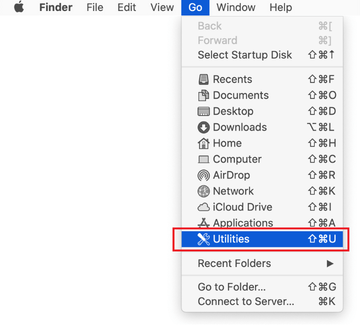
Locate the Activity Monitor icon on the Utilities screen and double-click on it.
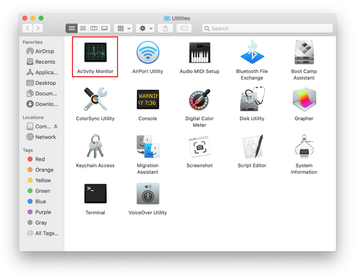
In the Activity Monitor app, look for a process that appears suspicious. To narrow down your search, focus on unfamiliar resource-intensive entries on the list. Keep in mind that its name isn’t necessarily related to the way the threat is manifesting itself, so you’ll need to trust your own judgement. If you pinpoint the culprit, select it and click on the Stop icon in the upper left-hand corner of the screen.
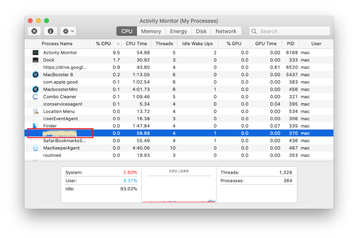
When a follow-up dialog pops up asking if you are sure you want to quit the troublemaking process, select the Force Quit option.
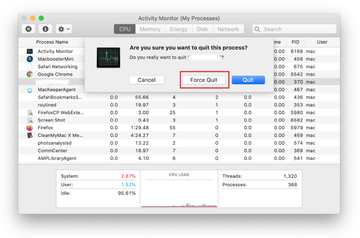
Click on the Go menu icon in the Finder again and select Go to Folder. You can as well use the Command-Shift-G keyboard shortcut.
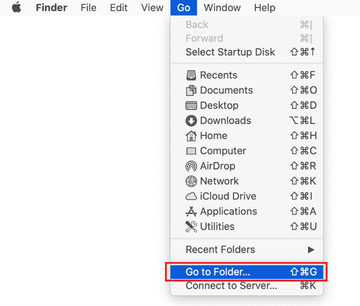
Type /Library/LaunchAgents in the folder search dialog and click on the Go button.
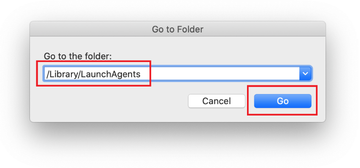
Examine the contents of the LaunchAgents folder for dubious-looking items. Be advised that the names of files spawned by malware may give no clear clues that they are malicious, so you should look for recently added entities that appear to deviate from the norm.
As an illustration, here are several examples of LaunchAgents related to mainstream Mac infections: com.updater.mcy.plist, com.avickUpd.plist, and com.msp.agent.plist. If you spot files that don’t belong on the list, go ahead and drag them to the Trash.
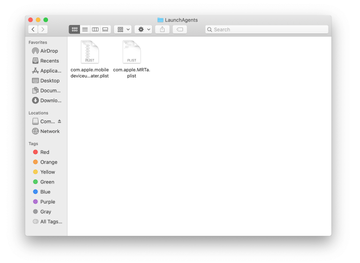
Use the Go to Folder lookup feature again to navigate to the folder named ~/Library/Application Support (note the tilde symbol prepended to the path).

When the Application Support directory is opened, identify recently generated suspicious folders in it and send them to the Trash. A quick tip is to look for items whose names have nothing to do with Apple products or apps you knowingly installed. A few examples of known-malicious folder names are ProgressSite and IdeaShared.
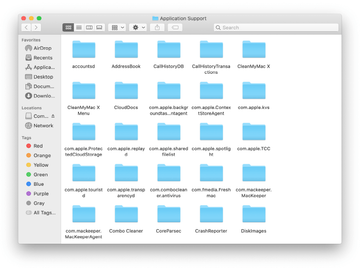
Enter ~/Library/LaunchAgents string (don’t forget to include the tilde character) in the Go to Folder search area.
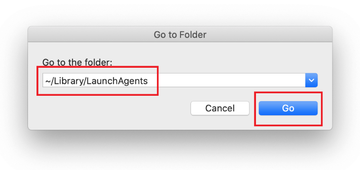
The system will display LaunchAgents residing in the current user’s Home directory. Look for dodgy items related to the rogue VTDecoderXPCService process (see logic highlighted in subsections above) and drag the suspects to the Trash.
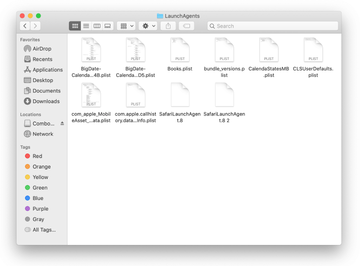
Type /Library/LaunchDaemons in the Go to Folder search field.
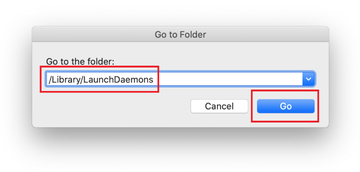
In the LaunchDaemons path, try to pinpoint the files the malware is using for persistence. Several examples of such items cropped by Mac infections are com.apple.sysmond.plist, com.startup.plist, and com.ExpertModuleSearchDaemon.plist. Delete the sketchy files immediately.
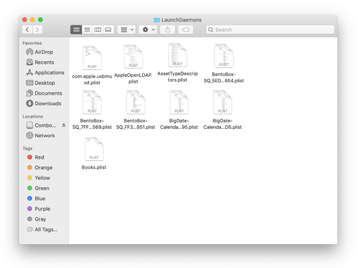
Click on the Go menu icon in your Mac’s Finder and select Applications on the list.
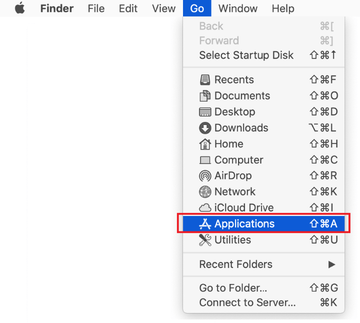
Find the entry for an app that clearly doesn’t belong there and move it to the Trash. If this action requires your admin password for confirmation, go ahead and enter it.

Expand the Apple menu and select System Preferences.
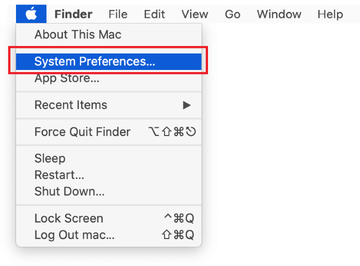
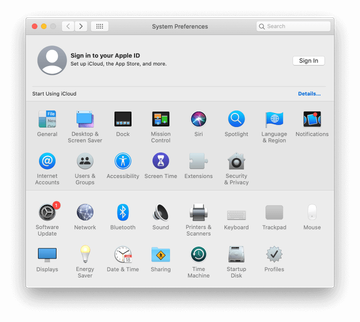
Proceed to Users & Groups and click on the Login Items tab.
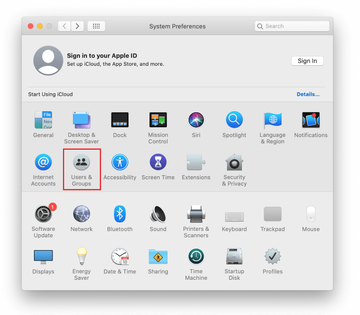
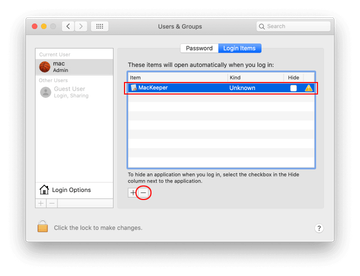
Now select Profiles under System Preferences. Look for a malicious item in the left-hand sidebar. Several examples of configuration profiles created by Mac adware include TechSignalSearch, MainSearchPlatform, AdminPrefs, and Safari Settings. Select the offending entity and click on the minus sign at the bottom to eliminate it.
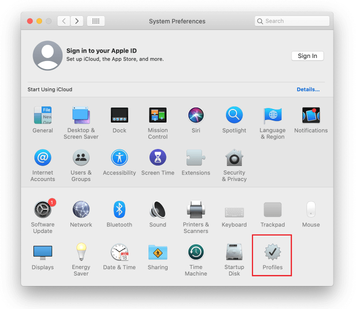
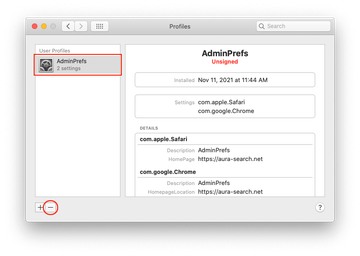
Get rid of VTDecoderXPCService related malware in web browser on Mac
To begin with, the web browser settings taken over by the malware that’s abusing VTDecoderXPCService should be restored to their default values. Although this will clear most of your customizations, web surfing history, and all temporary data stored by websites, the malicious interference should be terminated likewise. The overview of the steps for completing this procedure is as follows:
- Fix the VTDecoderXPCService problem in Safari
- Open the browser and go to Safari menu. Select Preferences in the drop-down list.
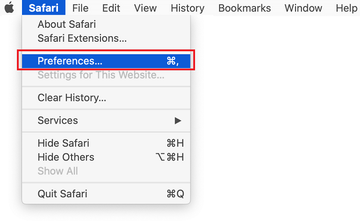
- Once the Preferences screen appears, click on the Advanced tab and enable the option saying “Show Develop menu in menu bar”.
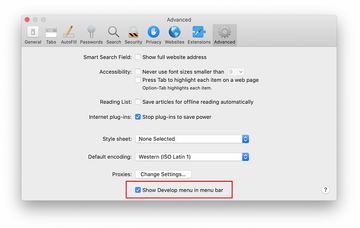
- Now that the Develop entry has been added to the Safari menu, expand it and click on Empty Caches.
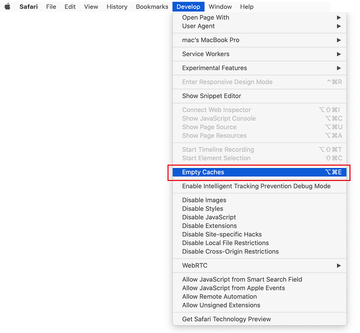
- Now select History in the Safari menu and click on Clear History in the drop-down list.
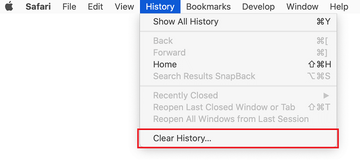
- Safari will display a dialog asking you to specify the period of time this action will apply to. Select all history to ensure a maximum effect. Click on the Clear History button to confirm and exit.

- Go back to the Safari Preferences and hit the Privacy tab at the top. Find the option that says Manage Website Data and click on it.

- The browser will display a follow-up screen listing the websites that have stored data about your Internet activities. This dialog additionally includes a brief description of what the removal does: you may be logged out of some services and encounter other changes of website behavior after the procedure. If you’re okay with that, go ahead and click on the Remove All button.
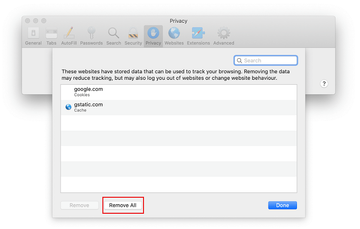
- Restart Safari
- Open the browser and go to Safari menu. Select Preferences in the drop-down list.
- Fix VTDecoderXPCService problem in Google Chrome
- Open Chrome, click the Customize and control Google Chrome (⁝) icon in the top right-hand part of the window, and select Settings in the drop-down
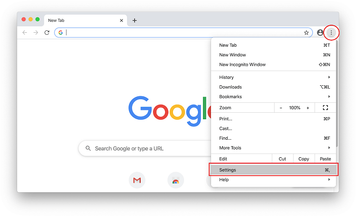
- When on the Settings pane, select Advanced
- Scroll down to the Reset settings section.
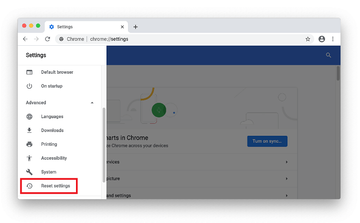
- Confirm the Chrome reset on a dialog that will pop up. When the procedure is completed, relaunch the browser and check it for malware activity.
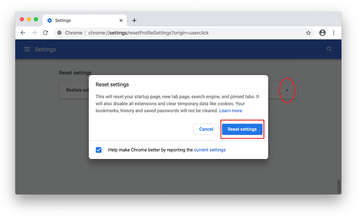
- Open Chrome, click the Customize and control Google Chrome (⁝) icon in the top right-hand part of the window, and select Settings in the drop-down
- Remove VTDecoderXPCService malware in Mozilla Firefox
- Open Firefox and go to Help – Troubleshooting Information (or type about:support in the URL bar and press Enter).
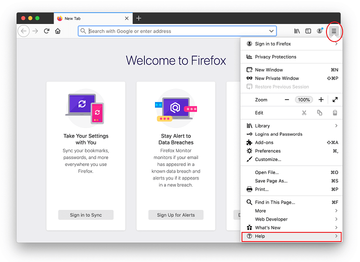
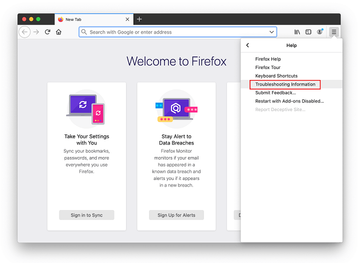
- When on the Troubleshooting Information screen, click on the Refresh Firefox button.
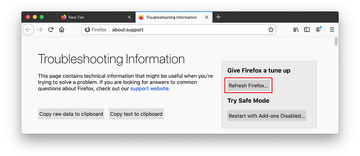
- Confirm the intended changes and restart Firefox.
- Open Firefox and go to Help – Troubleshooting Information (or type about:support in the URL bar and press Enter).
Fix VTDecoderXPCService high CPU and memory issue using Combo Cleaner removal tool
The Mac maintenance and security app called Combo Cleaner is a one-stop tool to detect and remove VTDecoderXPCService virus. This technique has substantial benefits over manual cleanup, because the utility gets hourly virus definition updates and can accurately spot even the newest Mac infections.
Furthermore, the automatic solution will find the core files of the malware deep down the system structure, which might otherwise be a challenge to locate. Here’s a walkthrough to sort out the VTDecoderXPCService issue using Combo Cleaner:
Download Combo Cleaner installer. When done, double-click the combocleaner.dmg file and follow the prompts to install the tool onto your Mac.
By downloading any applications recommended on this website you agree to our Terms and Conditions and Privacy Policy. The free scanner checks whether your Mac is infected. To get rid of malware, you need to purchase the Premium version of Combo Cleaner.
Open the app from your Launchpad and let it run an update of the malware signature database to make sure it can identify the latest threats.
Click the Start Combo Scan button to check your Mac for malicious activity as well as performance issues.
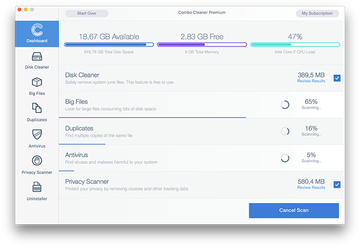
Examine the scan results. If the report says “No Threats”, then you are on the right track with the manual cleaning and can safely proceed to tidy up the web browser that may continue to act up due to the after-effects of the malware attack (see instructions above).
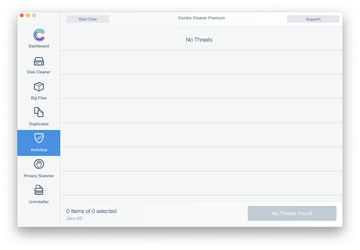
In case Combo Cleaner has detected malicious code, click the Remove Selected Items button and have the utility remove VTDecoderXPCService threat along with any other viruses, PUPs (potentially unwanted programs), or junk files that don’t belong on your Mac.
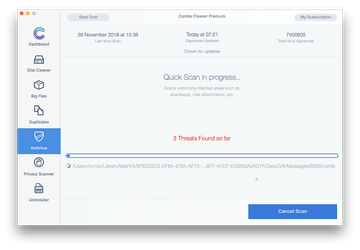
Once you have made doubly sure that the malicious app is uninstalled, the browser-level troubleshooting might still be on your to-do list. If your preferred browser is affected, resort to the previous section of this tutorial to revert to hassle-free web surfing.
